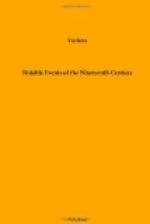For a while it was insisted by astronomers and the world at large that the new globe, then supposed to bound the solar system on its outer circumference, should be called Herschel, in honor of its discoverer. But the old system of naming the planets after the deities of classical and pagan mythology prevailed; and to the names of Mercury, Venus, Mars, Jupiter, Saturn, was now added the name Uranus, that is, in the language of the Greeks, Heaven.
Piazzi, scanning the zodiac from his observatory in Palermo, in the early hours of that first night of the century, noticed a hitherto unobserved star, which under higher power proved to be a planet. It presented a small irregular disc, and a few additional observations showed that it was progressing in the usual manner from west to east. For some time such a revelation had been expected; but the result did not answer to expectation in one particular; for the new body seemed to be too insignificant to be called a world. It appeared rather to be a great planetary boulder, as if our Mount Shasta had been wrenched from the earth and flung into space. Investigation showed that the new body was more than a hundred miles in diameter; but this, according to planetary estimation, is only the measurement of a clod.
There had been, as we say, expectation of a discovery in the region where the first asteroid was found. Kepler had declared his belief that in this region of space a new world might be discovered. Following this suggestion, the German astronomer Olbers, of Bremen, had formed an association of twenty-four observers in different parts of Europe, who should divide among themselves the zodiacal band, and begin a system of independent scrutiny, either to verify or disprove Kepler’s hypothesis.
There was another reason also of no small influence tending to the same end. Johann Elert Bode, another German astronomer, born in 1747 and living to 1826, had propounded a mathematical formula known as Bode’s Law, which led those who accepted it to the belief that a planet would be found in what is now known as the asteroidal space. Bode’s Law, so-called, seems to be no real law of planetary distribution; and yet the coincidences which are found under the application of the law are such as to arouse our interest if not to produce a conviction of the truth of the principle involved. Here, then, is the mathematical formula, which is known as Bode’s Law:
Write from left to right a row of 4’s and under these, beginning with the second 4, place a geometrical series beginning with 3 and increasing by the ratio of 2; add the two columns together, and we have a series running 4, 7, 10, etc.; and this row of results has an astonishing coincidence, or approximate coincidence with the relative distances of the planets from the sun—thus:
4 4 4 4 4 4 4 4
4
3 6 12 24
48 96 192 384
— — —
— — — —–
—– —–
4 7 10 16 28 52 100 196 388




